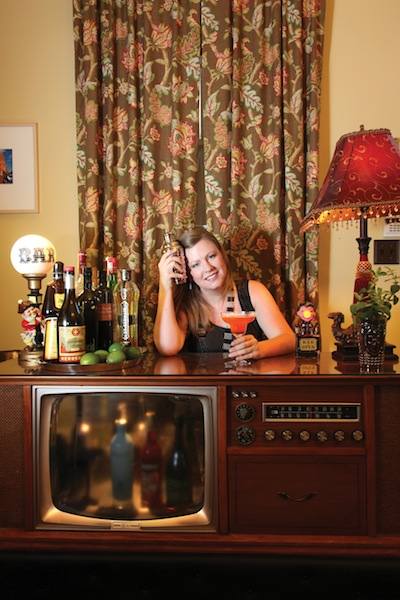According to the people who track these sorts of things, real cocktails are the new black. A genuine cocktail made with an intoxicating liquor or two, some rare bitters, and a generous shake over chipped ice has replaced the martini bar, cigar bar, wine bar and beer garden. May the peanut butter and jelly martini never return.
As restaurants and bars place little-known liquors and exotic elixirs behind the stick, home cocktailians rush to convert the wine cellar or home brew area into a bar worthy of a visit from Kingsley Amis. Paul Tuennerman, co-founder of Tales of the Cocktail explains, “Personal bars are just that, personal. They’re very telling of the individual, their level of sophistication, particular drink preferences and entertainment style.”
Tuennerman splits his time between two bars. One is in the bathroom vanity of the 900-square foot apartment he shares with his wife, Ann, in New Orleans. A space normally reserved for hairbrushes, toothpaste and other sundry items has now become the best stocked bathroom in New Orleans. His other bar is on board his sailboat, “Mr. Cocktail,” which he keeps in Dallas. There, bottles are stashed in bilges, drawers and engine compartments.
Ray Bordelon’s home bar began with one spoon. One day while perusing an antique store on Magazine Street, he discovered a flat, shovel-shaped, slotted spoon and wondered what it was. What Bordelon held in his hand was an absinthe trowel, and the point at the end of the spoon is intended to help the drinker mix and break up sugar in the bottom of a V-shaped glass. The slots drip water through sugar and into the pale elixir, turning it a creamy green.
Bordelon’s house, a picture-perfect Greek Revival in Uptown New Orleans, is now studded with treasures, all celebrating his love of the ritual of drinking absinthe. “I equate drinking absinthe with a Japanese tea ceremony.” Bordelon says.
Downstairs is the modest absinthe bar, a high-backed curio cabinet filled with bottles bearing the names Kubler, Vieux Pontarlier, Marteau and others. A small, marble-topped counter is filled with glasses, spoons and bistro saucers emblazoned with prices on the lip of the plate. Those prices, and sometimes colors, could allow a waiter to total up a patron’s check in a moment’s notice and keep the sweat from the glass from soiling someone’s clothes.
Upstairs is a recreation of the original layout of what was first called the Absinthe Room, but is now known as the Old Absinthe House. A 10-foot bar anchors a back wall. On top, a marble obelisk crowned by a golden statue stands ready to dispense cold water. More bottles of absinthe line every open flat surface. Posters from the late 19th Century implore patrons to drink Pernod. There are tables and chairs, some set with packs of cigarettes and playing cards, others with glasses and old French newspapers. Bordelon’s bar is a Belle Epoque masterpiece.
In general, most of Bordelon’s collection comes from French antique hunts he goes on once a year. The reason reflects a cultural difference in how France and America took their doses, which is the proper term for a ration of absinthe. In France, the waiter at a café would bring you a carafe notched with dose marks, a glass of water, a specific absinthe glass, sugar and the absinthe trowel. The customer in France would then mix his drink to desired strength. In America, the drink was made for the customer by the bartender.
And how does Bordelon indulge in the Green Fairy? “I am a traditionalist,” he says, “I like mine with sugar and the water to be dripped over the sugar and into the absinthe.
History also plays a part in Wendy Waren and Drue Deshotels’ home bar. Well, one of their bars anyway; they have three official bar areas in their Irish Channel house. When Deshotels’ grandmother passed away, the only thing he wanted was an old, hulking 1950 Curtis Mathes television. Warren, Deshotels and a friend spent a weekend converting the television into something more useful: a bar. They replaced the screen with a glass panel that reveals a collection of liquors from around the world. Leather tufted bunting, wheels to make it portable and a vintage bar lamp complete the transformation from boob tube to booze cruiser.
Five o’clock is the customary cocktail hour in the Waren/Deshotels household. Their cocktail ritual is usually a drink before dinner and sometimes with dinner. While Waren does not have a routine cocktail, she likes to play around with luxury cognacs and flavored spirits. Her favorite cocktails usually involve St. Germain, pear cognac, Domaine de Canton, or Luxardo. “Right now, I’m drinking a cocktail with grapefruit juice, simple syrup, Luxardo and club soda,” Waren explains.
For Tuennerman, a home bar is a party space. For Waren and Deshotels, it’s a creative thing, while Bordelon’s bar allows him to “see, taste, feel, hear and touch history.” All are the hallmarks of a good bar, no matter where it’s located.





